This post is the sixth in BlogHer’s
Inspiration to Fitness series. To start from week one,
click here. Our first 4 workouts can be found
here,
here,
here, and
here.
You've been working out for weeks, maybe months. Your body is getting stronger, and you are making progress. Then, all of a sudden you hit a plateau. Even though you might be working out every day, your body is no longer changing. What happened?
Your body has become too good at the exercises that you have perfected. Your heart, lungs and muscles aren't being challenged the way they were in the beginning. Your body needs a wake up call!
To keep making progress, you need to challenge your body in different ways. That's one of the reasons that we have added intervals to your cardio workouts. Regularly switching things up will not only keep your workouts more interesting, but will also give you better results. Periodized training will produce greater gains in strength and lean muscle. It will also increase body fat reduction. Sounds good to me!
So how do we switch things up? Here are a few ways:
- Change the number of repetitions per exercise, or the number of sets that you complete.
- Change the amount of resistance.
- Change the type of resistance (i.e. use resistance bands instead of hand weights).
- Change the amount of rest time between exercises or sets.
- Change the speed that you complete the exercise (i.e. slower reps with lower weights)
- Challenge with balance (i.e. stand on one leg or on a rolled up towel)
Now for your homework!
Your 3 days of cardio will include the interval training that we introduced last week with more time in the high intensity interval:
-5 minute warmup RPE of 3
-2 minutes RPE 5
-60 seconds RPE 7-8
-2 minutes RPE 5
-60 seconds RPE 7-8
-2 minutes RPE 5
-60 seconds RPE 7-8
-2 minutes RPE 5
-60 seconds RPE 7-8
-5 minutes cooldown RPE 3
Your strength workout includes an introduction to plyometric training with jump squats. If you don't feel comfortable with the jumping, you can substitute regular squats.
Dynamic Warmup

Make huge circles with your arms as fast as you can. Do 15 forward, then 15 backwards.

Stand tall with your feet shoulder-width apart. Step forward with your right foot and kick your left foot as high as possible while reaching foward with your right hand to meet your left foot. Repeat with opposite leg and hand. Continue alternating legs for 15 repetitions.
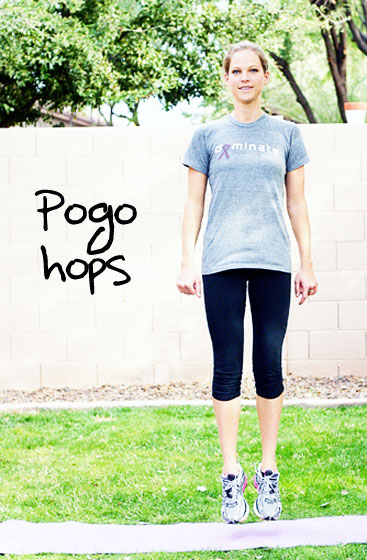
Jump a few inches off the ground and land on the balls of your feet. Continue for 15 repetitions.

Standing with feet together, bring arms in front of your body and cross one over the other. Swing them open then quickly back in front of your body. Make big moves and complete 15 repetitions.
Core Exercises
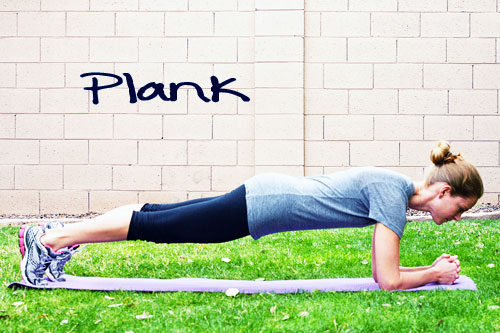
From a push up position, rest your weight on your forearms instead of your hands. Form a straight line with your body from your shoulders to your ankles. Hold yourself in this position by keeping your core tight and bellybutton drawn in. Hold for 30 seconds. Work up to holding the plank for 60 seconds or more. If your lower back starts hurting, check your form.
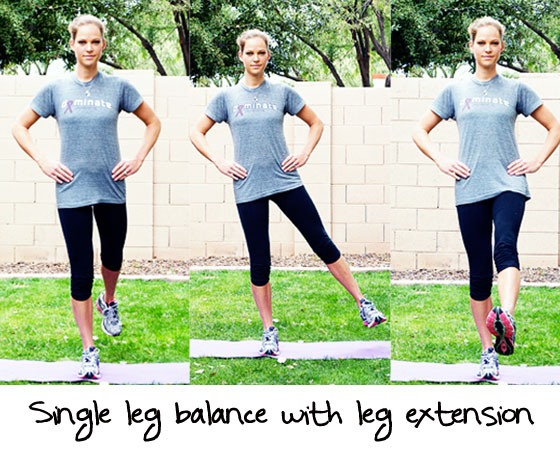
Stand on your right foot with your left food an inch or so off the ground. With hands on hips and bellybutton tight, extend your leg to the rear, back to the middle, to the left, back to the middle and to the front. Return to starting position and repeat. Do 15 repetitions and then switch to the opposite leg. Focus on challenging yourself to keep your balance throughout the exercise.
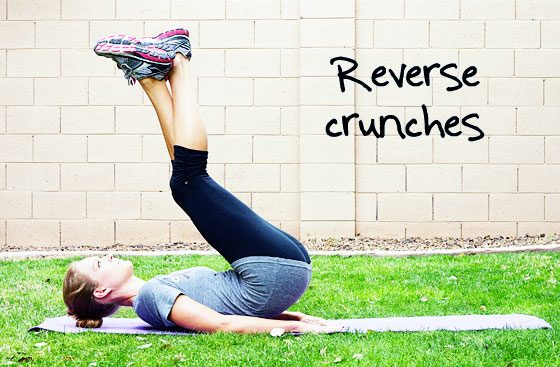
Lie on your back with knees bent, and extend arms down your sides with fingers pointing toward your toes. Gently exhale and stabilize your core muscles. Cross your legs at the ankles and slowly bring your legs back and up "crunching" your abdominal muscles. Inhale and slowly lower legs to starting position. Repeat.
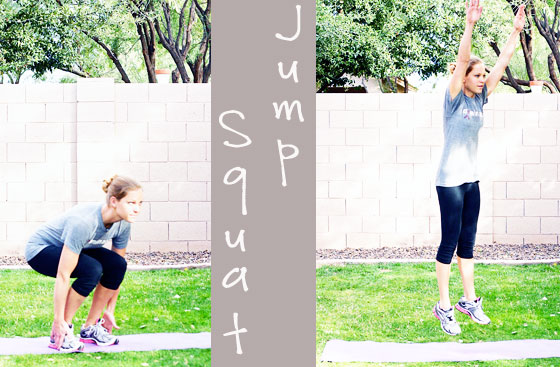
From a standing position with feet hip-width apart. Engage core muscles and lower into a squat. Touch the outside of your shoes with your fingers and jump up, driving off the balls of your feet, reaching into the air with your arms. Land softly on the balls of your feet and repeat without pausing. (Alternate exercise: squats)

Perform a push up. At the top of the push up, rotate your body into a side plank position with one hand on the other ground and the other hand pointed up toward the sky. Slowly rotate back to push up position and perform another push up. At the top of the next push up, rotate to the other side. Make sure your hip doesn't dip!
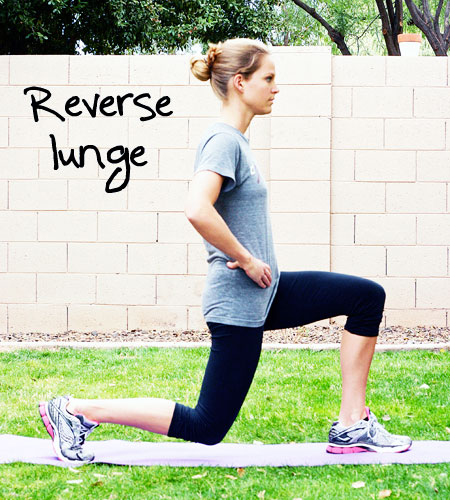
Standing with feet hip-width apart, step backwards into a lunge position with your right leg. Make sure legs are in a 90 degree angle and your forward knee isn't going past your toes. Push off the right leg back into starting position and switch legs.
Lie on your back with knees bent and feet flat on the floor. Bring arms out to a "T" position with forearms resting on the floor. Shoulder blades should be pulled down and back for the entire exercise. Keeping back flat on the floor, slowly rotate your arms forward and down toward the floor. Hands should end up 2-4 inches off the ground. Hold for 15 seconds then return to starting position. Repeat.
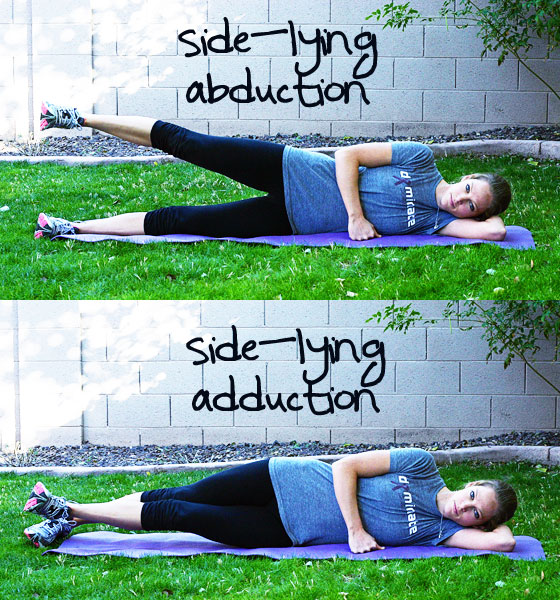
Abduction: Lie on your side with legs straight out and feet stacked. Make sure your body is properly aligned and engage your core muscles. Raise the upper leg as high as you can while maintaining posture. Hips and knees should be pointed forward at all times. Lower back to starting position and repeat. Do all reps on one side before switching to other leg.
Adduction: Lie on your side with legs straight out and feet stacked. Bring lower leg forward and gently raise off the floor, squeezing inner thigh muscle. Lower back to the ground and repeat. Do all reps on one side before switching to other leg.
Stretching
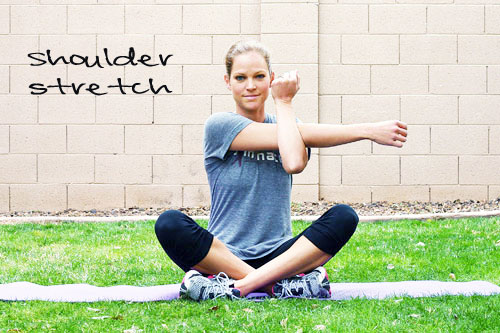
From a seated position, extend your right arm across your body in a straight line. Reach your left arm up and pull gently back on your right arm, stretching the shoulder. Hold for 30-60 seconds then repeat with other arm.
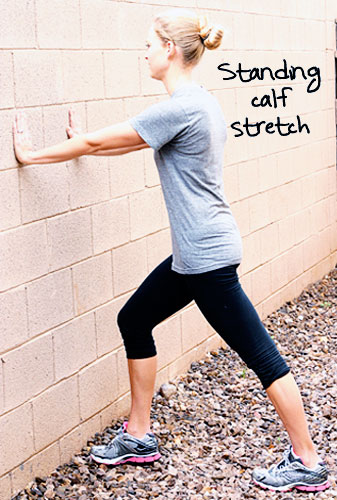
Stand facing a wall with right foot close to the wall and left leg staggered behind you. Place hands on the wall and push back into your left leg, feeling the stretch in your calf muscle. Hold for 30-60 seconds without bouncing, keeping left leg straight. Repeat on opposite leg.
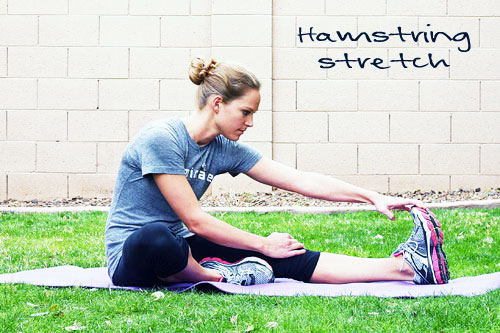
From a seated position, extend left leg out front and bring right foot towards left thigh. Reach forward with your left arm as far as possible while keeping leg straight. Hold for 30-60 seconds then repeat on opposite leg.
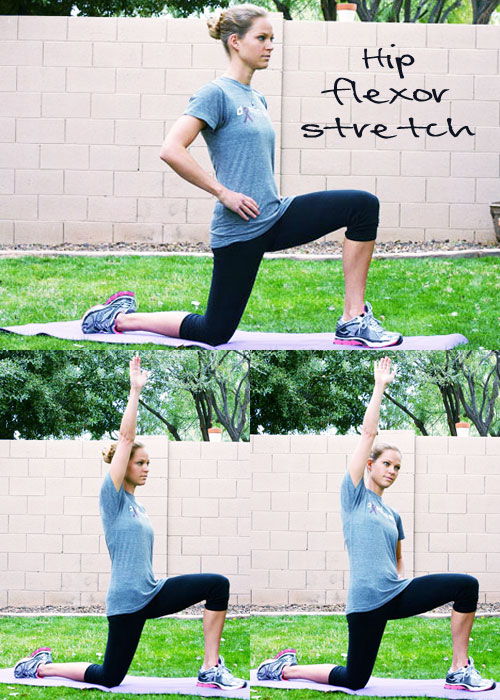
From a kneeling position, bring left leg out front with foot flat on the ground. Push body forward through the hips, stretching that right hip flexor. Hold for 30 seconds, then bring right arm straight up, slightly twisting body to the right and leaning to the left to go further into the stretch. Hold for 20 more seconds then repeat process on opposite side.
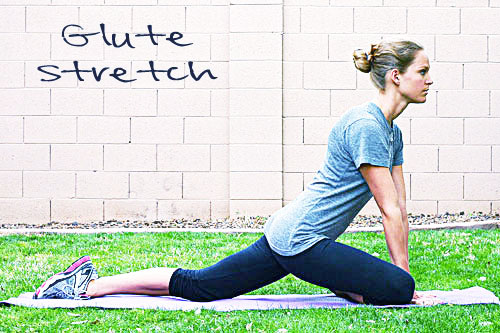
From a kneeling position, cross right leg in front of body while extending left leg back. Place hands on floor and sink into the stretch. You can extend even further into the stretch by walking hands out front and bringing chest towards the floor. Hold for 30-60 seconds then repeat on opposite side.

From a kneeling position, bring your arms out in front of you, sink your hips back into your heels, and rest your chest on your knees. Sink into the pose and relax all of your muscles. Hold for 30-60 seconds.
Foam Roller (optional)
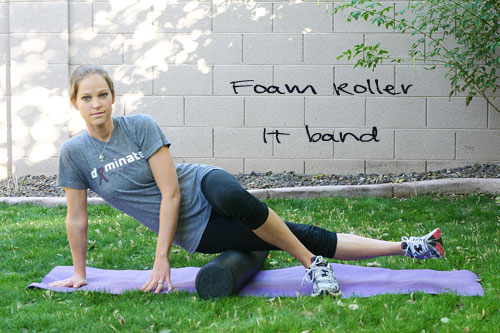
Lie on your right side and place your right hip onto the foam roller. Place your hands on the floor for support. Cross your left leg over your right with foot flat on the floor. Roll from your hip towards your knee in small movements. If you come across a spot that is particularly painful, hold the position for 30 seconds before moving on. Repeat on opposite side.
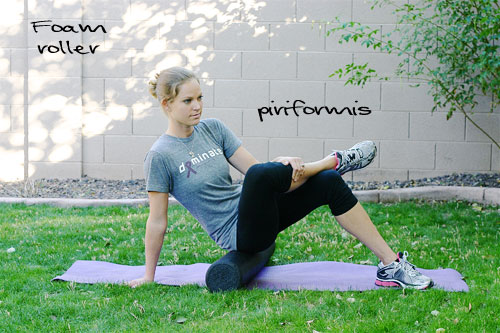
Sit on foam roller with it positioned under your right glute. Cross your right leg over your left and lean into the muscle. Roll back and forth in small movements while shifting your body slightly to roll all of the muscle. If you find a spot that is particularly painful, hold for 30 seconds before continuing. Repeat on opposite leg.
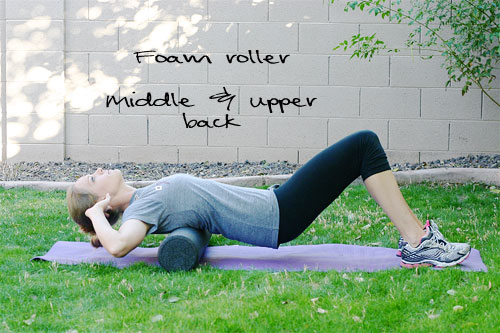
Lie faceup with foam roller under your upper back and feet flat on the floor. Roll from the top of your back to the middle of your back in small movements with your hips elevated off the floor. If you find a spot that is particularly painful, hold for 30 seconds before moving on. Be sure not to roll your lower back as this could cause injury.
Sit on the floor with your legs stretched in front of you. Place the foam roller under your right calf. Cross your left leg over your right ankle. Use your hands behind you for support and raise your body off the ground. Roll forward and back on your calf muscle. Repeat on opposite leg.
* Don't forget to leave a comment on my
Buyer's Guide telling me which products you would love to own for a chance to win!
 Strap on the goggles and fire up your DeLorean, it's time to go back to the future of American health care. Unfortunately, Marty McFly's booked. So our traveling companion is Mary -- a 50-year-old, middle-income, single woman with diabetes.
Strap on the goggles and fire up your DeLorean, it's time to go back to the future of American health care. Unfortunately, Marty McFly's booked. So our traveling companion is Mary -- a 50-year-old, middle-income, single woman with diabetes.
Last week, we met up with her
to examine some of the ways the medical, technological, and political ideas swirling around in 2012 -- ideas still unhatched and far beyond her control -- might impact her future health 13 years from now. Using potential scenarios for U.S. health care as defined in a new report, our "time-traveling" pals at the Institute for Alternative Futures laid out four possibilities for Mary's health care in the year 2025.
Watch the videos below for a refresher on the four scenarios. Then, as promised, read the analysis of Clem Bezold, founder of IAF, who explains what would need to happen over the next 13 years for each of those scenarios to become reality.
And don't forget to check out the final results of our audience poll from last week -- found at the bottom of the post -- to see where your ideas on the future of U.S. health care stack up with the other participants.
SCENARIO 1: "Many Needs, Many Models," or the "Expectable Future"
Bezold: "Among many health care experts, this is the most likely forecast for U.S. health care. It may not be the most preferable, but there's enough inertia in the system to prompt a fair amount of positive change. In this scenario, we have electronic medical records that work, there are advances in system integration, digital coaches have become relatively effective, and the personalization of health care has improved significantly. The good news is we double the percentage of people in integrated care from 20 to 40 percent -- but the bad news is we only double it. The rest remain in fee-for-service or semi-integrated care. So we see improvements, but they're not uniformly distributed.
"To get to this scenario, we assume the Affordable Care Act has been implemented fairly successfully, but the improvements in changing the health care system are modest. We add people to the rolls for health coverage, but we end up with shortages. The employers generally look at the new health insurance exchanges and say they're effective enough, and that they'd prefer to get out of providing health care. So employers continue dropping coverage or shifting to consumer-directed health plans with defined contributions and high deductibles. The triple aim of health care reform -- enhancing the patient's experience, reducing per capita health care costs, and improving the overall health of the population -- has been accepted by most integrated health care systems. Most providers, though, remain unintegrated and the payers don't require it. And that's largely because health reform's Accountable Care Organizations, which were designed to integrate care, haven't been implemented as widely and successfully as they could have been by 2025."
SCENARIO 2: "Lost Decade, Lost Health," or a "Challenging Future"
Bezold: "In this scenario, the Supreme Court has ruled the individual mandate of health care reform unconstitutional, eliminating a major component of the Affordable Care Act. The United States has made huge investments in electronic medical records but they're not fully interoperable and therefore aren't very effective. In the meantime, prices keep going up, and a lot of people are now uninsured. So they seek out free digital coaches to substitute for regular check-ups. The problem is that advertising revenues fund many of these digital coaches that are free to patients, and many independent providers of these free digital coaches don't adequately check the quality, safety or efficacy of what their advertisers are selling.
"To top it all off, the United States has suffered recurring recessions, several tied to the European financial crisis. And due to that fact, there have been periodic and significant budget cuts -- 10 percent cuts in health care spending happened twice within two or three years of each other. One was in 2013 when Congress failed to find a patch for the Sustainable Growth Rate formula that reimburses doctors for their Medicare services. The second slashed Medicare and Medicaid reimbursement rates yet again to cope with ever-rising health care costs. Physicians are being told to do more and get less -- and their stresses continue to get worse. Some health care providers just go out of business, including some community health centers. To be sure, there have still been some developments, including the discovery of a successful treatment for Alzheimer's, but you have to be rich to get them. Even if you have health insurance, most plans have stopped covering a number of the cutting-edge, expensive treatments."
SCENARIO 3: "Primary Care That Works for All," or an "Aspiring Future"
Bezold: "In this scenario, the Affordable Care Act has done very well in moving people toward integrated care. In general, the system also continues to move health care delivery systems into integrated care that focuses on prevention, takes full advantage of digital health coaching and utilizes the entire health care team. Leading health care officials have made a concerted effort to ensure that patient-centered medical homes have evolved into robust community centered health homes. In practice, they see themselves as treating the entire community and addressing social determinants of health in a neighborhood or region, in addition to treating patients. Things have gone well due to a combination factors, including the successful implementation of the ACA - particularly the success of Accountable Care Organizations which have fully integrated and simplified care -- as well as greater transparency of costs and real competition among providers.
"All of that has resulted in much more patient satisfaction. Incentives have shifted enough to encourage the medical community to use the entire team more efficiently. There's less use of physicians and more use of others in the team, including community health workers. It's been found that more and better care can be provided by using people further down on the chain. Community health workers have less training than nurses, but they can visit patients in their homes and effectively reinforce the information, diagnosis and advice from the health care provider. The recommendations are based on the latest medical protocols, the patient's bio-monitoring and community health assessments. It's become increasingly apparent that by focusing on prevention and taking a community-focused approach, you can get better outcomes for less cost."
SCENARIO 4: "I Am My Own Medical Home," or a "Surprisingly Successful Future"
Bezold: "In scenario four, much of health care moves into integrated systems that work, but the United States also has some economic challenges that have interfered. So we don't get the same degree of access to the effective integrated health care we saw in Scenario 3. The individual mandate within health reform has been ruled unconstitutional, and that means no one is forced to have insurance. We're also seeing a continuing movement where employers stop offering their employees full benefits. Individuals have to be ready to shell out a fair amount of money to get good health insurance -- and many people do that -- but another 40 percent of them say they can handle their health care on their own.
"In fact, technology, competitive insurance plans, and transparency of quality and price for providers, tests and procedures have allowed many individuals and families to self-manage their health care quite well. Most of these people have determined that they either can't afford full health coverage and consumer-directed plans help people take control of their own health care. Forty percent end up using technology and consumer-directed plans to become their "own medical home" and an equal amount buy their health care though integrated plans. For those managing their own care, there are very effective tools that allow people to buy health care "by the piece." For example, if someone needs a test and she can't do it at home, there's an equivalent of Angie's List that links up with that individual's digital health coach to find the result that will work best for them. The same is true for routine care -- it's easy to shop around. Because this consumer-directed care is so effective and lowers cost, it puts a cost pressure on integrated systems to become more efficient and effective. Another positive development is that consumer-directed plans include a very effective digital health coach, with all accompanying advertisements vetted by health insurance companies to ensure the quality of their messages and the safety of consumers."
Which scenario do you think is most likely? Check out the results of the NewsHour poll conducted over the past week. While it's far from scientific, the poll does indicate that many of the participants have a "very gloomy" outlook for U.S. health care, Bezold said. He offers his own assessment below.
Here are the results of a NewsHour poll that asked viewers to rate the relative likelihood of each scenario. Raw scores have been converted to averages:
Scenario 1: "Expectable Future": 60 percent likelihood (average of 5.95 out of 10 for 65 voting)
Scenario 2: "Challenging Future": 70 percent likelihood (average of 6.96 with 78 voting)
Scenario 3: "Aspiring Future": 53 percent likelihood (average of 5.27 with 60 voting)
Scenario 4: "Surprisingly Successful Future": 42 percent (average of 4.15 with 61 voting)
The above results are based on ballots cast between Jan. 31 and Feb. 7. Continue voting here:
Rate SCENARIO 1: "Expectable Future"
Rate SCENARIO 2: "Challenging Future"
Rate SCENARIO 3: "Aspiring Future"
Rate SCENARIO 4: "Surprisingly Successful Future"
here.
Bezold: "In terms of relative likelihood, my own opinion is that Scenario 1 is about 55 percent likely, Scenario 2 is about 45 percent likely, Scenario 3 is 38 percent likely, and Scenario 4 is 38 percent likely. I pick Scenario 1 as the likeliest because it includes the strongest aggregation of forces in terms of where we're headed. While I don't like that it's most likely -- especially because we've only doubled the number of people in integrated care -- we will see a number of advances in a whole range of things built into that scenario. So it's not all bad news."
The scenarios were developed in consultation with some of the top health care experts in the country, and with the support of The Kresge Foundation, which is also a NewsHour underwriter. Read the full report
here.
“Parents who frequently move house put children’s health at risk,” according to the Daily Mail. The newspaper said that research found moving several times can affect children’s health and psychological state, and also increases the likelihood that a child may use illegal drugs.
This Scottish research, which looked at potential links between moving house in childhood and adult health, produced far more mixed results than the Mail implied. However, the press release accompanying the research did not always clearly reflect the findings of the study, which found very few significant links between moving frequently and poor health.
In fact, once the researchers accounted for factors such as social deprivation and moving schools, moving house was only significantly linked to a higher chance of using drugs in later life. Adults who had moved frequently showed no greater risk of being overweight, having high blood pressure, long-term illness, psychological distress, drinking or smoking later in life.
While researchers say the risk of having certain measures of poor health was “elevated” in people who moved house more frequently as a child, the increase in risk was not statistically significant, which means it could have happened by chance.
Where did the story come from?
The study was carried out by researchers from the Medical Research Council, the University of Stirling, Queen’s University and Scotland’s Chief Scientist Office. It was funded by the Chief Scientist Office of the Scottish Government Health Directorate. The study was published in the peer-reviewed Journal of Epidemiology and Community Health.
The study’s findings were overstated by the Daily Mail. The newspaper reported that there were “negative health effects” from frequent moves, whereas the study found that frequent moving was only significantly linked to an increased chance of drug use. This finding on drug use was found to be independent of other variables.
Moving during childhood was not significantly associated with adult measures of physical health, such as weight and blood pressure. The Mail only touched on these elements towards the end of its report.
It’s worth noting that in the press release that accompanied publication of the study, it only the penultimate paragraph stated only illegal drug use was independently associated with frequent moves.
What kind of research was this?
This research was part of a large cohort study from the west of Scotland, which has taken place over 20 years. Its aim was to compare the health of people who had been “residentially stable” during childhood with those who had moved house, using a range of health measures.
The authors say previous research suggests that frequent childhood moves may be associated with poorer health outcomes and behaviour in adolescence. The researchers say their present study brings together a wider range of health outcomes than has previously been considered, and also looked at the extent to which associations between childhood mobility and health in adolescence last into adulthood.
What did the research involve?
The study was based on a cohort of 1,515 participants who were 15 when it started in 1987 and who were followed up for 20 years. Data from this cohort were collected at five points in time, the final time when the participants were 36. The final sample analysed in the study was 850 participants, so 665 original participants (44%) were not included in the final analysis because they had left the study.
Researchers collected their data through face-to-face interviews conducted by nurses. A parental questionnaire was completed at the start of the study.
The researchers got information about moving house from the number of addresses people had lived at between birth and 18 (they excluded recent moves out of the family home). They collected information on a range of health measures including:
- Physical health measures - these were all taken by nurses and included body mass index, waist-to-hip ratio, lung function and blood pressure.
- Overall health - people were asked to report whether they had limiting long-term illness (answering yes or no) and to give their own assessment of their general health, as rated on a four-point scale.
- Psychological distress - this was assessed using a standard 12-item questionnaire (with a cut-off score of 3 points taken to indicate psychological distress). Whether people had thought about suicide was also examined, with people asked at certain points whether they had thought about taking a drug overdose or deliberate self-injury. The third measure of psychological distress was anxiety, as measured on a standard scale.
- Health behaviours - the behaviours examined were heavy drinking (defined as exceeding maximum weekly safe limits), illegal drug use and smoking.
Importantly, the researchers also looked at participants’ family and household circumstances based on information provided by the children’s parents at the start. They also looked at other factors such as social deprivation (calculated by postcode and using recognised deprivation categories), housing status (home owner or not), social class, family structure (intact or not) and number of siblings. Also included were data on school mobility, derived from the number of primary and secondary schools attended. The researchers also looked at participants’ social class, education and marital status in adulthood.
The researchers then analysed the relationship between number of house moves in childhood and health at the ages of 18 and 36. They adjusted their findings for possible confounders, such as social class, deprivation and family circumstances.
What were the basic results?
The researchers found that approximately one in five people did not move address throughout childhood. Three in ten moved once or twice, and a further one in five had moved at least three times. They also found that children in single-parent households and those with two or three siblings were significantly more likely to have moved home (while those with at least four siblings were more likely to have stayed put).
After they adjusted their findings for both socioeconomic circumstances and the number of school moves, the researchers found that, when the participants were 18:
- People who had moved at least three times were significantly more likely to have used illegal drugs than those who had never moved (odds ration [OR] 2.44, 95% confidence interval [CI] 1.45 to 4.10).
- Those who moved at least once had a significantly higher chance of scoring 3 or more (indicating distress) on the questionnaire for psychological distress than those who had not moved at all (OR=1.62, 95% CI 1.11 to 2.35).
- The risk of several outcomes (having a long-term illness, having suicidal thoughts for those who had moved at least once, and heavy drinking and smoking for those who had moved at least three times) were “elevated” compared to those who had not moved at all, but the increased risks were not significant.
- There was no association between childhood mobility and physical health measures such as blood pressure and weight.
When the participants were aged 36, the researchers found that:
- Frequent moving in childhood was independently associated with illegal drug use (OR 1.92, 95% CI 1.00 to 3.69).
- The odds of poor health across other measures remained “elevated” but not statistically significant.
- There was no association between moving address during childhood and physical health measures such as blood pressure and weight.
How did the researchers interpret the results?
The researchers concluded that increased residential mobility in childhood is associated with an elevated risk of poor health in adulthood, across a range of measures. This is explained in part, they say, by both social and economic circumstances and the frequency of school moves.
The relationship between childhood residential mobility and poorer health appeared to be stronger in adolescence than adulthood, possibly because people’s own socioeconomic circumstances lessened the effects over time.
Conclusion
This study looked at the effect of multiple address moves during childhood on people’s physical and psychological health at the ages of 18 and 36.
The way the authors interpreted the results of their study is confusing. They say that a higher risk of poor health outcomes is associated with frequent moves of home in childhood. However, the only significantly higher risk, once the results were adjusted for various confounders, was illegal drug use. This is important because it means that the other increases in risk identified are more likely to have occurred by chance.
The study examined an important issue, and one strength is the length of time of it covered. Another is its detailed collection of data, which might help explain why frequent moves of house could have an association with poorer health outcomes. For example, this could be because of frequent school moves, family break-up and deprivation.
However, the study has a number of limitations. Its high drop-out rate (around 43%) raises the question of reliability and it is possible that those who dropped out or were lost to follow-up also had the most mobile childhoods. The study’s reliance on the parents to report outcomes, such as overall health, is another limitation as their reports may be subjective or difficult to appraise.
Families move home for a range of different reasons, including improved schooling and employment opportunities, change in financial circumstances or family break-up, and the study did not assess the reasons for the family moves. It seems obvious that children are more likely to be negatively affected when disruption or financial problems cause a family to move, rather than when the motive is to seek better schools or a better job.
The way children’s wellbeing is affected by frequent moving is an important issue, but it is also a complex one which needs to be examined further.
Links To The Headlines
Parents who frequently move house 'put children's health at risk'. Daily Mail, February 9 2012
Links To Science
Brown D, Benzeval M, Gayle V et al.
Childhood residential mobility and health in late adolescence and adulthood: findings from the West of Scotland Twenty-07 Study. Journal of Epidemiology and Community Health, Published Online First 6 February 2012

There is no standard definition for the word healthy, but in my private practice I sometimes find that if a food has even one healthy attribute it may be given a health halo.

-Jennifer Purdie, 34-year-old Ironman athlete and marathon runner

My chilly-weather breakfast is a formula that can be mixed and matched according to taste. The basic components include a grain, a fruit, and a nut. Most often, I choose oatmeal as my grain, banana as my fruit, and walnuts as my nut. However, this basic structure can be adjusted by substituting farina (ground wheat) or grits (ground cornmeal) in place of the oatmeal, apples or pears in place of bananas, and almonds or pecans for the nut. Any combination works well and does the trick.
My favorite warm-weather breakfast is plain yogurt, sliced fruit, a splash of agave or maple syrup, and a slice of whole grain bread. Again, the combination of yogurt, fruit, and bread provides the protein, complex carbohydrates, and fat needed to jumpstart the day and stay fueled through the morning.
-Elizabeth Robinson, athlete, personal trainer, and creator of online fitness program
VitFit

-Erin Aquino, fitness fiend

-JL Fields, founder/editor/writer of
JL Goes Vegan and
Stop Chasing Skinny

The balance of fruit, fat, and oats makes it filling and energy-packed.
-Stephen Cooper, personal trainer and founder of
Boot Camp Pasadena

-Jason Fitzgerald is a 2:39 marathoner and founder of
StrengthRunning.com

PJ's Organics' Breakfast Burrito is the perfect breakfast after exercising since it offers sustenance and fills you up for hours. As the perfect healthy authentic Mexican breakfast at home, this item contains no pesticides, preservatives, or GMO's, and is one of the only nourishing organic frozen burritos on the market.
-Rachel Dubin, fitness fiend

-Gillian Barrett, runner and exerciser who lost 80 pounds the right way

-
Len Saunders, author of
Keeping Kids Fit

I also like banana smoothies. I freeze banana chunks and pop them in my Vitamix with almond milk, a little Sun Warrior protein powder, and a small spoon of peanut butter. Banana is high in sugar so I only do this when I'm off to a high-intensity workout. It tastes like a milkshake!
-Gillian Casten of
RateYourBurn.com
You don't need us to remind you that eating a
healthy breakfast is a good idea. But since the same bowl of oatmeal every day can get boring, you might need a few new ideas for
what
to eat in the morning.
"Whether you are headed to the gym or on your way out the door to work, make sure your breakfast is going to keep you going for the next few hours," says Ed Olko, personal trainer at Equinox in Palos Verdes, CA.

Drink your dessert on V-Day in the form of this deliciously fizzy libation originally concocted by The Cocktail Guru, Jonathan Pogash. Thanks to dark chocolate vodka, you'll taste the complex flavors of cocoa with intoxicating notes of coffee and caramel.
Ingredients:
?1 large strawberry, chopped
?Handful of mint leaves
?1 tsp. agave nectar
?1/4 oz. fresh lemon juice
1 1/2 oz. Van Gogh Dutch Chocolate Vodka
?3 oz. sparkling wine or Champagne
Directions:
Muddle the strawberry and mint with agave and lemon. Add Van Gogh Dutch Chocolate and strain into chilled Champagne flute. Top with the sparkling wine or Champagne. Garnish with a strawberry slice on the rim.

Toast your fun and fabulous friends with this fruity Champagne-based cocktail. Created by Kim Haasarud of Liquid Architecture, the bubbly drink is guaranteed to put everyone in high spirits.
Ingredients:
2 basil leaves, sliced into thin strips
?3 pitted bing cherries, plus 2 for garnish
?1/2 oz. gin
?1/2 oz. simple syrup
?1/2 oz. lime juice
?3 oz. Moet & Chandon Rose Imperial
Directions:
Combine basil, cherries, lime juice, gin and simple syrup in a shaker; muddle. Top with ice and shake vigorously. Pour contents into a highball glass and top off with Moet & Chandon Rose Imperial.

The premium organic green tea used to make this 95-calorie mojito, mingled with a dash of lime and white rum, gives the drink a cool, refreshing aroma. Agave nectar keeps it light but sweet, while the addition of fresh mint transports you to a tropical paradise all your own.
Ingredients:
8-10 fresh mint leaves
2 tbsp. agave
2 spoonfuls of
DAVIDsTEA Silk Dragon Jasmine
1 c. hot water
2 tbsp. lime juice
1 c. club soda
4 oz. white rum
Directions:
Muddle mint leaves with a bit of agave at the bottom of your pitcher, then cover with ice. Steep tea and strain into pitcher. Add lime juice, agave, club soda, and rum; stir to combine. Garnish with a mint sprig.
Makes four servings.

The list of tasty ways to enjoy green tea is seemingly endless (We know because
we tried to count and stopped at 20). You can whip up a low-calorie cocktail with antioxidant-rich matcha powder too! A little agave nectar and a squeeze of lemon blend sweetness and tartness for the perfect-tasting potion.
Ingredients:
?1 part Soju
2 parts filtered water
1 tsp.
Gotcha Matcha
1 tsp. agave nectar
Juice of half a meyer lemon
Directions:
In a martini shaker, shake all the ingredients well. Pour over fresh ice cubes. Serve with a lemon wedge. Optional: Add fresh mint or ginger.

For the easiest cocktail you've ever made, simply pour your friends or special someone a glass of this ready-made drink. Each pre-mixed serving is low in calories and totally lightweight. Even better, the pomegranate cosmo flavor is brimming with the essence of healthy pomegranate and cranberry.
Ingredients:
VnC Cocktails Pomegranate Cosmopolitan
Directions:
Pour into a glass and enjoy!

Your friends (and you) will fall in love at first sip with this potent potion. The vodka, distilled from coconut nectar, gives the easy-to-make drink an incredibly smooth finish.
Ingredients:
2 oz. VuQo Premium Vodka
1 oz. Champagne
1/2 oz. Chamboard
Directions:
Stir ingredients and serve in a champagne glass.

Bellinis are typically super sweet, sugary drinks, but this irresistible version by celebrity party planner and chef Travis London works well for a calorie-conscious diet. Premium French vodka, bursting with the delectable flavors of blood oranges, mango, and passion fruit, stars in this drink alongside mango puree for one can't-put-it-down bevvie.
Ingredients:
1 1/2 oz. X-Rated Fusion Liqueur
2 1/2 oz. mango puree
Top with Rose Brut Sparkling Wine
Directions:
In a cocktail shaker, add X-Rated Fusion Liqueur, mango puree, and ice. Shake vigorously and strain into a champagne flute rimmed with rimming sugar. Top with sparkling wine.

Whip up Travis London's tempting thirst quencher right before a fun night out. Ginger-infused vodka gives the beverage an exotic kick, while agave nectar helps keep the calorie count down.
Ingredients:
1 1/2 oz. X-Rated Fusion Liqueur
1 oz. SKYY Infusions Ginger
1/2 oz. agave nectar
Top with Champagne
Directions:
In a cocktail shaker add X-Rated Fusion Liqueur, SKYY Infusions Ginger, agave nectar, and ice. Shake vigorously and strain into a champagne flute rimmed with sugar. Top with Champagne.

A creation of Igor Zukowiec of
ALCHEMIQ Mixology Services, this dreamy cocktail is the perfect V-Day tipple. It's infused with a light, unique floral essence from homemade hibiscus syrup, which is further enhanced by white rum and fruit-flavored water. And did we mention it's only 60 calories?
Ingredients:
3/4 oz. hibiscus syrup
2 oz. white rum
1 1/2 oz. Strawberry-Kiwi
Hint Water
3/4 oz. fresh lime juice
Directions:
To make hibiscus syrup, combine 1 c. agave nectar, 1 c. water, and 1 c. dried hibiscus flowers. Simmer for 5 minutes and let cool. Strain the syrup. Combine the drink ingredients, including hibiscus syrup, together in a mixing cup. Add ice and shake vigorously. Strain into a chilled cocktail glass and serve.
Photo by Filip Wolak.

This flavorful chocolate-y libation will definitely put you in an appropriately flirty mood. Plus, you'll benefit from the antioxidant-packed strawberries.
Ingredients:
1 oz. chocolate liqueur
1 oz. X-Rated Fusion Liqueur
3 strawberries
1/2 oz. SKYY Vodka
Directions:
In a cocktail shaker, place all ingredients and muddle the strawberries until completely mashed. Add ice, shake vigorously, and strain into a martini glass rimmed with red rimming sugar and garnish with a strawberry slice.

Tantalize your taste buds with this stimulating tipple, a fusion of citrus and ginger-flavored liqueurs. Single ladies—and taken ones too!—will down this yummy cocktail that tastes sweet but won't sabotage a healthy diet.
Ingredients:
1 1/2 oz. TY KU Citrus Liqueur
1/2 oz. Ginger Liqueur
Splash of white cranberry juice
Squeeze of fresh lime
Directions:
Shake ingredients together.

Clocking in at less than 100 calories, this concoction swaps out sugary drink mixes for a healthier rendition, plus a splash of diet soda. The result is an impressively low-cal cocktail you'll want to nurse all night long!
Ingredients:
1 1/2 oz. TY KU Liqueur
1 1/2 oz. TY KU Soju
Squeeze of lime
Splash of Diet Sprite
Directions:
Shake ingredients together.

Nothing says you're single and ready to mingle like this pretty pink brew. Mingle vodka with tart cranberry juice and lemon-lime club soda for a sparkling cocktail that won't expand your waistline.
Ingredients:
2 oz. VuQo Premium Vodka
1 oz. Sweet & Sour Mix
Splash of diet cranberry juice
Splash of lemon-lime club soda
Directions:
Shake ingredients and serve over ice.

For a fresh take on the mojito, try this quick and easy recipe. The tart citrus flavors of lemon and orange juice permeate this invigorating brew for a drink that's shockingly low in calories and sugar.
Ingredients:
2 oz. TY KU Liqueur
Splash of Sprite
Squeeze of lemon
Squeeze of orange
Directions:
Shake ingredients together.

While this creamy, dessert-like libation appears loaded in fat, it's not as bad as you might think! Choose light whipped cream to slash calories or skip it altogether for a drink that's still sweet but guilt free..
Ingredients:
1 1/2 oz. TY KU Soju
1/2 oz. Chocolate Liqueur
Top with light whipped cream
Directions:
Shake ingredients together.

Even if you don't get a real kiss on V-Day, you can pucker up to this mouthwatering potion filled with fruity berry flavor. Grenadine syrup gives the drink a festive tinge of color while offering a hint of sweetness too!
Ingredients:
1 part Pucker™ Raspberry Rave Vodka
1/4 part grenadine syrup
Lemon twist (optional)
Cherry
Directions:
Pour Pucker™ Raspberry Rave Vodka in a chilled champagne flute. Top with champagne and slowly pour syrup so that it settles to the bottom. Garnish with a lemon twist and a cherry.
Forget the chocolate! This Valentine's Day, play bartender at home for your single ladies or special someone.
These festive mixed drinks will give you just enough of a buzz to get your flirt on without packing on too many extra calories.
The City Council also handed the dairy farmers another victory by voting 5 to 4 against an amendment that would have required them to post a placard informing consumers of the potential health risks linked to drinking raw milk.
Raw milk is milk that hasn't been pasteurized to kill potentially harmful bacteria such as E. coli, Salmonella and E. coli that can cause severe illness.
The proposed placard, as drawn up by the city's Department of Health and Human Services, warned that children, pregnant women, the elderly and those living with conditions that weaken the immune system are at the greatest risk of becoming ill from drinking raw milk. It also warned that raw milk outbreaks are responsible for nearly three times more hospitalizations than outbreaks involving any other food.
The issue came before the City Council after the city's newly hired food-service inspector visited the Portland farmers' markets last fall and told the raw-milk vendors that sales of unpasteurized milk were not allowed there. That came as a surprise to the vendors, because they had been selling raw milk at the markets for several years, with no previous indications from the city that they weren't supposed to.
It turned out that although state law permits raw milk from state-licensed dairies to be sold at retail stores throughout the state, and even though raw milk is sold at other farmers' markets in the state, the city of Portland had its own list of items that can't be sold at its farmers' markets. Raw milk was on that list, even though it can be sold in stores in the city.
During the City Council meeting, Mayor Michael Brennan, who cast one of the four votes in favor of requiring the placard, made no comments about why he had voted that way. But in an email to Food Safety News after the meeting, he said he voted in favor of the placard because he believes it's important to provide "the most information" possible to consumers about "any number of food products."
He also said his vote supported the recommendation of the council committee that had originally proposed the placard, as well as the recommendation of the city's Department of Health and Human Services, "because both had reviewed the issue more fully."
During the council meeting, Heather Donahue, co-owner of
Balfour Farm and a raw-milk vendor at the city's Wednesday farmers' market, told council members that raw-milk farmers are required to inform customers that the milk hasn't been pasteurized by putting the words "not pasteurized" on the containers' labels.
She also pointed out that while in the past raw milk was a "significant" carrier of diseases, many improvements have been made since then. She said that to be certified as a raw-milk dairy in Maine, the dairy herd has to be tested at regular intervals and strict sanitation practices must be followed.
In an interview after the meeting, she told Food Safety News that she was relieved that raw-milk dairies won't have to display the placard about the potential health risks of raw milk.
"In general, the people who shop at farmers' markets know about raw milk and seek it out," she said. "They can get more information from us than they can from a store clerk."
She described the proposal to require the placard as "a wrinkle that needed to be ironed out."
Lauren Pignatello, co-owner of
Swallowtail Farm and Creamery and also the manager of Portland's winter farmers' market, said that if consumers are being informed about the health risks of raw milk, they should also be informed about what he sees as the benefits of drinking raw milk.
The
Centers for Disease Control and Prevention says there are no health benefits from drinking raw milk that cannot be obtained from drinking pasteurized milk that is free of disease-causing bacteria.
Raw-milk producer Lee Straw told council members that state-licensed raw-milk dairies are held to the same standards as conventional dairies.
"Even though the feds will say otherwise, by holding us to the same ordinances as pasteurized milk, the state seems to feel we can put out a safe product," he said.
But Portland resident Charles Bragdon took the opposite tack, telling the council members that raw milk is "very dangerous to some members of our population" and that providing people with information about the health risks is "important, if not critical."
Council member Cheryl Leeman, who voted in favor of requiring the placard, held up a newspaper featuring an article about a recent outbreak of food poisoning cases linked to a raw-milk dairy in Pennsylvania.
On Feb. 7, Pennsylvania health officials said there were 43 confirmed cases of
Campylobacter infections among people who drank raw milk sold by the Your Family Cow farm. Maryland public health officials confirmed that the outbreak strain of bacteria was detected in two unopened containers of unpasteurized milk from the Pennsylvania dairy.
"There is a health risk with raw milk," Leeman said, emphasizing the word "is."
At the same time, she acknowledged that there is "clearly a public demand for raw milk."
Looking at the issue from the perspective of a City Council member, Leeman said that because the issue is raw-milk sales on city property, the city should go along with its Health Department's recommendation requiring the placard.
"It's not an unreasonable request for those folks who want to sell raw milk on our property," she said, pointing out that with the placards, the city will have done its job of making sure the public is informed.
"Then, it will be up to the consumers to weigh the pros and cons," she said. "The final decision is really up to the consumers."
Council member Ed Suslovic had his own concerns, saying that if he were in a rush and grabbed a container of raw milk, it would be easy for him to miss the label saying that the milk hadn't been pasteurized.
"I'd like to see the placard," he said.
He even went so far as to say that he'd like to offer an amendment that would require informational placards at any point of sale for raw milk in the city, which would include retail stores as well as farmers' markets.
The amendment was not acted on.
When a council member asked why the the requirement for a placard was proposed in the first place, Douglas Gardner, director of the city's Health and Human Services Department, explained that it seemed appropriate to tie it in with the proposal that the city allow raw milk sales at its farmers' markets. That way consumers could have information about the basic risks associated with raw milk.
Through all of this, some council members struggled with the issue of fairness. If, for example, placards were to be required at the farmers markets but not at retail stores in the city, then the farmers' market vendors would be at a disadvantage.
Even council member John Anton, who made the motion to remove the requirement for a placard, said he wasn't basing his motion on public health arguments but rather concerns about how it would affect those who sell at farmers' markets, compared with those whose milk is sold in stores.
"It feels unfair and arbitrary," he said.
But he also said that if the city wanted a citywide requirement for an informational placard, he might support it.
In an interview after the meeting, Health Department director Gardner told Food Safety News that during the meeting, he heard several council members express an interest in looking at a citywide requirement for informational placards that would apply to all points of sale -- in stores as well as at farmers' markets.
"There was an interest at looking at a broader approach," he said.
Warnings or Not?
Food-safety attorney Bill Marler, publisher of Food Safety News, said that a warning sign, such as the one on the placard proposed by Portland, MEs health department, should be on a bottle of raw milk as well as at the place of sale of raw milk.
He provided this example of such a sign: "WARNING: This product has not been pasteurized and may contain harmful bacteria (not limited to E. coli O157:H7, Campylobacter, Listeria and Salmonella). Pregnant women, infants, children, the elderly and persons with lowered resistance to disease (immune compromised) have the highest risk of harm, which includes diarrhea, vomiting, fever, dehydration, Hemolytic Uremic Syndrome, Guillain-Barre Syndrome, reactive arthritis, irritable bowel syndrome, miscarriage, or death, from use of this product."
"Consumption of raw milk, especially for the young, the elderly and those with compromised immune systems, should be warned against," Marler said. "Just saying that the milk is not pasteurized is not enough."
Raw Milk in Maine
Amy Robbins, epidemiologist with Maine's Center for Disease Control of Prevention, said in an email to Food Safety News that in the past 5 years, no outbreaks related to raw (unpasteurized) milk products have been identified in Maine, although outbreaks related to raw (unpasteurized) milk products have occurred in other states. The state does not allow raw milk or raw milk products to be sold in restaurants, schools, hospitals or nursing homes. Maine, which has 32 dairy operations that are allowed to sell raw milk, and 65 licensed to sell cheese, is one of 11 states that allows the sale of raw milk at retail stores separate from the farm. Along with 7 other states, it has high standards for cleanliness of the milk, with a coliform standard of no more than 10 coliform bacteria per milliliter, which is equivalent to the national and some international standards for pasteurized milk.
For ten years now, the state of Georgia has been under the exclusive control of Republicans. Republican governor, Republican-controlled house of representatives and a Republican-controlled senate. All statewide offices are filled by Republicans, including the Office of Secretary of State, currently held by Brian Kemp who allowed the recent birther hearing to go forward, previously held by Karen Handel of recent Komen Foundation/Planned Parenthood fame. And to our eternal shame, we birthed Newt Gingrich upon the rest of the country. Our conservative bona fides are unassailable.
Yet, we (quite inconveniently for the current narrative) have this law on the books:
Well now, isn’t that just so very special?Official Code of Georgia Annotated § 33-24-59.6
Legislative Declaration Regarding Contraception; Coverage for Contraceptives.
(a) The General Assembly finds and declares that:
(1) Maternal and infant health are greatly improved when women have access to contraceptive supplies to prevent unintended pregnancies;
(2) Because many Americans hope to complete their families with two or three children, many women spend the majority of their reproductive lives trying to prevent pregnancy;
(3) Research has shown that 49 percent of all large group insurance plans do not routinely provide coverage for contraceptive drugs and devices. While virtually all health care plans cover prescription drugs generally, the absence of prescription contraceptive coverage is largely responsible for the fact that women spend 68 percent more in out-of-pocket expenses for health care than men; and
(4) Requiring insurance coverage for prescription drugs and devices for contraception is in the public interest in improving the health of mothers, children, and families and in providing for health insurance coverage which is fairer and more equitable.
(b) As used in this Code section, the term:
(1) "Health benefit policy" means any individual or group plan, policy, or contract for health care services issued, delivered, issued for delivery, or renewed in this state, including those contracts executed by the State of Georgia on behalf of state employees under Article 1 of Chapter 18 of Title 45, by a health care corporation, health maintenance organization, preferred provider organization, accident and sickness insurer, fraternal benefit society, hospital service corporation, medical service corporation, provider sponsored health care corporation, or other insurer or similar entity.
(2) "Insurer" means an accident and sickness insurer, fraternal benefit society, hospital service corporation, medical service corporation, health care corporation, health maintenance organization, or any similar entity authorized to issue contracts under this title.
(c) EVERY HEALTH BENEFIT POLICY THAT IS DELIVERED, ISSUED, EXECUTED, OR RENEWED IN THIS STATE or approved for issuance or renewal in this state by the Commissioner on or after July 1, 1999, WHICH PROVIDES COVERAGE FOR PRESCRIPTION DRUGS ON AN OUTPATIENT BASIS SHALL PROVIDE COVERAGE FOR ANY PRESCRIBED DRUG OR DEVICE APPROVED BY THE UNITED STATES FOOD AND DRUG ADMINISTRATION FOR USE AS A CONTRACEPTIVE. This Code section shall not apply to limited benefit policies described in paragraph (4) of subsection (e) of Code Section 33-30-12. Likewise, nothing contained in this Code section shall be construed to require any insurance company to provide coverage for abortion.
(d) No insurer shall impose upon any person receiving prescription contraceptive benefits pursuant to this Code section any:
(1) Copayment, coinsurance payment, or fee that is not equally imposed upon all individuals in the same benefit category, class, coinsurance level or copayment level, receiving benefits for prescription drugs; or
(2) Reduction in allowable reimbursement for prescription drug benefits.
(e) This Code section shall not be construed to:
(1) Require coverage for prescription coverage benefits in any contract, policy, or plan that does not otherwise provide coverage for prescription drugs; or
(2) Preclude the use of closed formularies; provided, however, that such formularies shall include oral, implant, and injectable contraceptive drugs, intrauterine devices, and prescription barrier methods.
Continue reading below the fold.
Love is in the air - and not just because Valentine's Day is right around the corner. It's also National Heart Month - a time to show our hearts a little love, and do what we can to reduce our risk heart disease, the leading cause of death in the United States.
Fortunately, there are things we can put in our cereal bowls, lunch boxes and dinner plates every day that can help reduce our own risk for developing heart disease. Not only that, a lot of these things can also be part of a healthy diet that can also reduce your risk of developing a variety of types of cancer. A two-for-one! Now who wouldn't love that?
Oats, beans, and apples
You've probably heard that we should eat more fiber. There are two types of fiber: soluble fiber, which helps reduce serum cholesterol levels and is therefore good for your heart; and insoluble fiber, which helps keep a healthy GI tract, which is good for your colon!
Oats, beans, and apples - along with other fruits, vegetables and grains - are great sources of primarily soluble fiber, but contain insoluble fiber, as well. In general, I tend to tell people to not get too hung up on what type of fiber they eat - just to eat more! Shoot for 25-30 grams of fiber each day. Check out
Jump on the ‘bran wagon' for better health to see how easy it is to get that amount with a little planning.
Bananas, berries, and broccoli
Eating more fruits and vegetables is important for reducing heart disease risk. Low in calories and bursting with nutrients, fruits and vegetables can help reduce high blood pressure (a risk factor for heart disease) and also may help with weight control - an important way to reduce your risk of both heart disease and cancer.
Shoot for at least 2.5 cups of colorful fruits and vegetables each day, and because we don't know which of the hundreds of nutrients that are packaged in produce are most protective for our health - eat a variety each day! Sprinkle berries on your cereal, add lettuce and tomato to your sandwich, or start your dinner with a salad topped with red peppers and carrots.
Brown rice, whole wheat pasta, and....popcorn
Brown rice, whole wheat pasta, and yes, even popcorn, are whole grains - foods that are packed with fiber and other nutrients that help regulate blood pressure. This same fiber and other nutrients may also help reduce the risk of colon cancer, and eating whole grains is a key component of the ACS recommendation to eat a mostly plant-based diet. Shoot for at least half your grain sources during the day to be whole grain - kick off the day with a 100% bran cereal, snack on some popcorn (skip the butter!), wrap your fish taco at dinner in a corn tortilla.
Salmon, tuna, and mackerel
These fish contain omega 3 fatty acids - a type of fat that may help reduce cholesterol and triglyceride levels, and also blood pressure. (Other sources include walnuts, flaxseed, and canola oil). The American Heart Association recommends that we eat fish - particularly these types - at least 2 times per week.
While it doesn't appear that eating fish high in omega-3s impact cancer risk, serving fish in place of red meat like beef, pork or lamb is a healthy swap, as red meat consumption is associated with an increased risk of colon cancer. So why not swap out a filet mignon with a filet of salmon sometime this week?
Avocados, nuts, and seeds
Not only can these foods add some great texture and flavor to your diet, they also provide heart-healthy poly- and monounsaturated fats which can help lower your cholesterol. For years, we used to think the type of fat you eat impacted cancer risk, but the research just hasn't panned out on this. While these foods may not directly influence cancer risk, they can and should be included as part of an overall healthy diet. One thing to keep in mind - they are high in calories, so you don't want to go overboard!
Red wine and dark chocolate
Well, we can't talk about heart health around Valentine's Day and not bring up red wine and dark chocolate! Moderate alcohol consumption (no more than 1 drink per day for women and 2 for men) is associated with reduced heart disease risk. Red wine, with its particularly high level of antioxidants, has been linked for years with heart health, although the jury is still out on this (some studies suggest that grape juice may have the same impact). Similarly, some studies suggest that small amounts of high quality dark chocolate (look for those labeled with ‘at least 70% cocoa') may also offer some heart-healthy benefits due to its high levels of antioxidants.
Not to be a buzz-kill (pun intended), but both of these are examples of how too much of a good thing is not a good thing. Even though moderate consumption of red wine may reduce heart disease risk, risk of breast cancer increases at this level. And too much dark chocolate? That's a lot of extra calories, sugar, and fat. But a 5-oz. glass of cabernet and a small piece of dark chocolate with your Valentine....? You decide!
What will you start doing TODAY to reduce your risk of heart disease and cancer?
Editor's note: This blog was originally published on the
American Cancer Society Choose You blog.
Doyle is director of nutrition and physical activity for the American Cancer Society.
In a large analysis of men participating in a prostate drug trial, researchers at the
Duke Cancer Institute found a significant correlation between
coronary artery disease and
prostate cancer, suggesting the two conditions may have shared causes.
If confirmed that heart disease is a risk factor for prostate cancer, the malignancy might be combated in part by lifestyle changes such as weight loss, exercise and a healthy diet, which are known to prevent heart disease.
"What's good for the heart may be good for the prostate," said Jean-Alfred Thomas II, MD, a post-doctoral fellow in the
Division of Urology at Duke and lead author of the study, which appears online this month in the journal
Cancer Epidemiology, Biomarkers & Prevention.
Coronary artery disease kills more adults in the United States than any other cause, accounting for one in four deaths. Risk factors include inactivity, obesity, high blood pressure and cholesterol, cigarette smoking, and diabetes.
Similarly, prostate cancer is a common killer. It's the second-most lethal cancer for U.S. men, behind lung cancer, with about 240,000 new cases diagnosed a year, and 34,000 deaths. Previous studies exploring the relationship between coronary artery disease and prostate cancer risk have found conflicting results, making it difficult to determine whether the malignancy is fueled by poor lifestyle choices.
In the current study, the Duke team used data from 6,390 men enrolled in a large study called REDUCE, a four-year, randomized trial to test the prostate cancer risk reduction benefits of a drug called dutasteride. All the study participants had a prostate biopsy at the two- and four-year marks, regardless of their PSA levels. They also provided a detailed medical history that included their weight, incidence of heart disease, alcohol intake, medication use, and other factors.
Among the men in the study, 547 reported a pre-enrollment history of coronary artery disease. This group of men tended to be older, heavier and less healthy, with higher baseline PSA levels, plus more diabetes, hypertension, and high cholesterol. The men were also much more likely to develop prostate cancer, even after accounting for all the baseline differences.
Having coronary artery disease increased the men's risk of prostate cancer by 35 percent, with the risk rising over time. The group was 24 percent more likely to be diagnosed with prostate cancer within the first two years of the study than men who reported no heart disease, and by four years into the study, this group's prostate cancer risk was 74 percent higher.
"We controlled for a number of risk factors, including hypertension, taking statins, or aspirin," Thomas said. "We don't have a good grasp on what's causing the link, but we are observing this association."
Stephen Freedland, MD, associate professor of surgery and pathology in the Division of Urology at Duke and senior author of the paper, said the study had some shortcomings. Notably, it relied on data from a previous trial that didn't account for factors such as diet, physical activity and severity of heart disease that may have influenced the results.
But Freedland said the study eliminated a screening bias common in previous findings that correlated prostate cancer and heart disease using men with high PSA levels.
"This is giving us a lot of good ideas for what to look at next," Freedland said, noting that the overlap between prostate cancer and other diseases associated with poor health habits is a focus of his research group.
In addition to Thomas and Freedland, study authors from Duke include Leah Gerber; Lionel L. Banez; and Daniel M. Moreira. The Duke authors also hold positions in the surgery section of the Durham VA Medical Center. Study author Roger S. Rittmaster is from GlaxoSmithKline; Gerald L. Andriole is from Washington University School of Medicine in St. Louis.
Freedland and Andriole are paid consultants to GSK and have research support from the company.
The study was supported by GSK; the Department of Veterans Affairs; Duke University Department of Surgery and Division of Urology; Department of Defense Prostate Cancer Research Program; and the American Urological Association Foundation/Astellas Rising Star in Urology Award.

about clergy writing health care policy.
Ever since the Obama administration announced that the Affordable Care Act will require health insurers to cover contraception without co-pays, a tiny handful of very angry men have been shrieking that Obama is waging a war on religion, and especially the Catholic Church, and it will be the end of freedom and democracy as we know it.
These very angry men claim to speak on behalf of God. And all God-fearing Americans. The reality, however, is quite different. Today, for example, leaders from 23 different religious organizations
released a letter of support for the new policy.
Polling has
repeatedly shown not only that a majority of Americans support the new policy, but that a majority of
Catholics
support it as well. So while the church clergy may rail against the use of contraception, their congregants in the pews clearly do not agree.
While the administration has repeatedly stated its commitment to implementing this new policy, it also continues to state its desire to work with Catholic leaders to allay their unfounded fears (see above re: end of democracy and civilization). Today, during a White House press briefing, Press Secretary Jay Carney said:
The commitment to make sure that all American women no matter where they work have access to the same health care coverage and same preventive care services, including contraception, is absolutely firm. That’s the President’s commitment, that's explicit in the policy proposal. The discussion, and it's an important one, but the discussion is how can we, in implementing this policy, try to allay some of the concerns that have been expressed? And the President is very sensitive to that. As is Secretary Sebelius and others. But that's the issue. So, describe that as you will but there is no change in the commitment to ensuring that women have access to these important services.
This is on the heels of Obama adviser David Axelrod's appearance
yesterday on MSNBC's
Morning Joe
, where
he said that the administration is still trying "to find a resolution that makes sense" to these Church leaders, that it wants to "resolve it in an appropriate way," and that it wants to "work through these issues in a thoughtful way."
The administration's commitment to this policy is to be applauded. But—and yes, there is a but—it is time for the administration to stop wasting its time trying to "allay concerns" and "find a resolution." This is a popular and sound
health care
policy, and there is absolutely no reason why church leaders should be writing health care policy. Further, given their ultimate goal of banning all contraception and reproductive health care, there is no reason to think any "resolution" or compromise will allay their unfounded conspiracy theories that the president is waging a war on religion.
Today, for example, Sarah Posner at Religion Dispatches
reports that the U.S. Conference of Catholic Bishops has already preemptively rejected a possible "compromise" that has been floated. And because their hysterical hyperbole has no basis in reality to begin with, it's no less ridiculous for the administration to invest any time or energy assuring them that this health care policy will not, in fact, destroy the Catholic Church than it was for the administration to spend any time assuring birthers that he was not, in fact, at the center of a decades-long plot by the Kenyan government.
The president has the support of the American public on this policy. He has the support of American Catholics on this policy. He has the support of dozens of other religious organizations in this country.
It is time to stop "discussing" the Catholic leaders' paranoid delusions and focus on real problems facing this country. And reproductive health care for women leading to the end of civilization as we know it is
not
one of them.
“Spoon feeding makes babies fatter,” the BBC reported today. According to the broadcaster, babies weaned on pureed food tend to end up fatter than infants whose first tastes are finger foods.
This high-profile news is sure to be of interest to parents. However, the research behind the coverage is not strong enough to support such claims. The study compared information gathered on the diet and BMI of 92 child weaned on finger foods (“baby-led” weaning) and 63 children weaned using spoon-feeding. In total, 10 spoon-fed children were above a healthy weight compared to nine in the baby-led weaning group. However, the reliability of the research is undermined by a number of shortcomings, such as the small number of children studied (just 155), the fact that most children in each group had a normal weight and because the study looked at eating habits at a single point in time, rather than recording them over time.
Overall, the study does not support the various claims in the media that spoon-feeding makes babies fatter or encourages a sweet tooth, or that baby-led weaning makes children healthier. It is possible, for example, that a child’s food preferences might influence how they end up being weaned, or even that the results are due to chance. Examining the issue will require larger studies which look at children’s eating and weight over time.
Where did the story come from?
The study was carried out by researchers from the University of Nottingham, which also funded the research. The study was published in the
peer-reviewed medical journal BMJ Open.
The study was reported uncritically in most papers, with quotes from independent experts who reportedly supported its findings.
What kind of research was this?
This small
cross-sectional study examined the association between weaning method, food preferences and frequency of food consumption. The researchers were also interested in how heavy the children were for their height (body mass index or BMI) and whether they were “picky eaters”. The researchers say that at present, little evidence is available on the possible impact of different weaning methods on food preferences and health, but that baby-led weaning is associated with “reduced maternal anxiety” about feeding and “a maternal feeding style that is low in control”.
This study compared two groups of parents who used different weaning methods for their children and looked at their children’s food preferences and BMI. However, it cannot prove cause and effect, nor can it show that baby-led weaning results in healthier food choices and healthier weight. A more reliable method of assessing this question would be a
randomised controlled trial in which parents were randomly allocated one of the two weaning methods to use, and their babies followed over a period of time to see whether weaning method led to differences in dietary preference or BMI. However, such as trial may have ethical and feasibility issues.
Alternatively, a
prospective study that followed children weaned by the two methods over a period of time would also be preferable to a cross-sectional study, which only looks at weaning methods, children’s food preferences and other factors at one point in time.
What did the research involve?
The researchers recruited the parents of 155 children aged 20-78 months between June 2006 and January 2009. The group that used baby-led weaning were recruited by advertising on the internet while those who used spoon-feeding were recruited from the researchers’ own laboratory database.
All the parents completed a standard questionnaire which asked about:
- their infants’ feeding and weaning style
- their infants’ preferences for 151 foods (with ratings from 1 “loves it” to 5 “hates it”) – the preferences were then analysed by standard food categories, such as carbohydrates, proteins and dairy, and there was also a category for whole meals, such as lasagne
- their frequency of consuming particular foods (with ratings from 1 “more than once a day” to 7 “less than once a month”)
- whether they would classify their children as picky eaters
- the children’s height and weight
The parents’ socioeconomic status was also assessed using validated measures.
The researchers pointed out that because no formal definition of weaning exists, they used the parents’ own reports of weaning styles to divide parents into two groups. To try to verify these self-reported methods, they also questioned some parents in more detail about weaning.
As the baby-led weaning group tended to be younger than the spoon-fed group, the researchers carried out their analyses on food preferences and weaning method using a sub-sample of 74 infants – 37 from the spoon-fed group matched by age to 37 from the baby-led weaning group. They used the whole sample for all other analyses.
What were the basic results?
The general trend in results was as follows:
- Carbohydrates were the most popular food category for the baby-led weaning group, who liked carbohydrates more than the spoon-fed group.
- Sweet foods were most liked by the spoon-fed group.
- Preference and frequency of consumption were not influenced by socioeconomic status, although an increased liking for vegetables was associated with a higher social class.
- Using NHS BMI guidelines, eight children in the spoon-fed group were obese (12.7%) compared to none in the baby-led group. However, nine children in the baby-led weaning group (14.3%) were overweight compared to two in the spoon-fed group (3.2%).
- Three children in the baby-led weaning group were classed as underweight (4.7%) compared to none in the spoon-fed group.
- No difference in picky eating was found between the two groups.
How did the researchers interpret the results?
The researchers concluded that “weaning style impacts on food preferences and health in early childhood.” They say their results suggest that the baby-led approach to weaning helps infants learn to regulate their food intake in a way that leads to healthier weight and a preference for healthy foods, such as carbohydrates.
Conclusion
While it was widely reported, this small cross-sectional study proves very little about the possible impact of different weaning methods on children’s food preferences, BMI or other health outcomes. Instead, because of its cross-sectional design, it can provide only a snapshot of all these factors (as reported by parents) at one point in time. It cannot show, for example, that babies who prefer carbohydrates do so because they were weaned on finger foods, as some news sources have reported.
Many factors can affect a child’s food preferences and BMI, including genetic factors, exercise and social and demographic background (which was indicated to a degree by the fact that higher socioeconomic status was associated with higher vegetable intake). Though the study found differences in the BMI status of the children, the small sample size makes it difficult to draw reliable comparisons between the groups. For example, though eight children were obese in the spoon-fed group and none in the baby-led group, this finding could be due to chance. Also, when overweight and obese children were combined, ten children in the spoon-fed and nine in the baby-led groups were overweight or obese. This raises the strong possibility that there would be no real difference in BMI if a much larger group of children were looked at.
With rising rates of childhood obesity, the issue of how best to wean and how this might affect children’s attitudes to food and their long-term health is of concern to parents. However, a large-scale prospective study that follows babies for several years would be a much better way to shed light on the issue.
Links To The Headlines
Giving babies finger food could stop obesity. Sky News, February 7 2012
How giving babies finger food during weaning can stop them growing up fat. Daily Mail, February 7 2012
Spoon feeding 'makes babies fatter'. BBC News, February 7 2012
Baby weight: finger foods better than spoon-feeding, study suggests. The Guardian, February 7 2012
Links To Science
Townsend E, Pitchford NJ.
Baby knows best? The impact of weaning style on food preferences and body mass index in early childhood in a case–controlled sample. BMJ Open 2012;2:e000298 (published online)
Rules for
Senate Bill (SB) 81, which went into effect last Sept. 1, were not made public until Dec. 1 at a meeting of the Texas State Health Services Council.
At issue are labeling requirements for food items prepared by home kitchen retailers. The rules call for the burgeoning
cottage food industry in Texas to list the ingredients on the label for each product they sell. Home bakers think that requirement is ridiculous.
Rep. Lois Kolkhorst, chair of the Texas House Committee on Public Health, says the rules are "are a shining example of overreach." Her staff is telling Texas media that major food retailers have been at work influencing the rule-makers in the Texas Department of Health.
And the cottage food industry is saying it is being subjected to requirements stricter than commercial bakeries and restaurants have to follow. Kelly Masters, spokeswoman for the home kitchen bakers, asks how often Starbucks has to list the ingredients on labels for its bakery items.
As signed by Texas Gov. Rick Perry last June, SB 81 does include some labeling requirements. Specifically, the law says labels on retail goods produced in a home kitchen must include the name and address of the food producer and state that the products were made in an uninspected and unlicensed home kitchen.
However, other details were left up to the rule-making process.
SB 81 was a little more complicated than most cottage-food bills introduced and in some cases approved around the country. The Texas measure also set out to put fresh produce wholesalers under state regulation for the first time. When Gov. Perry signed the bill, the harvest, packaging, washing and shipping of all raw produce was put under a state inspection regime. Texas lawmakers were moved by reports of recent contamination and outbreaks involving produce such as tomatoes, spinach, and peppers, which previously had been viewed as too low-risk to merit state attention.
While SB 81 does not require a license to grow produce in Texas, it did require the Texas Department of Health to adopt rules for safe handling of fruits and vegetables.
State health officials are also required under the new law to provide "best practices" education programs to the food businesses they regulate. It also addresses regulation of farmers' markets in larger Texas counties that have local health departments, and prevents officials from mandating "temperature control requirements."
All of that churned up a lengthy rule-writing assignment for an agency that currently regulates 11,000 licensed food producers. Agency officials anticipate that only a few existing licensed food establishments will switch over to becoming unlicensed cottage-food operations.
The new law includes definitions for "baked goods" and "cottage-food production operation." It prohibits local health departments from regulating them, but requires both state and local health departments to keep records of any complaints they get about cottage foods.
Rule-makers produced 12 pages of requirements for the new law in a document roughly four times longer than the bill itself. The new rules state, in part:
"A cottage food production operation allows an individual to operate out of the individual's home, who produces a baked good, a canned jam or jelly, or a dried herb or herb mix for sale at the person's home; has an annual gross income of $50,000 or less from the sale of the described foods; and sells the foods produced only directly to consumers."
Labels must state the food was "made in home kitchen, food is not inspected by the Department of State Health Services or a local health department" in at least the equivalent of 11-point font and in a color that provides a clear contrast to the background.
The rules also require that "ingredients shall include components of the ingredients" and also dictate the ink and typeface requirements. Internet sales are prohibited and no health claims can be made in advertising.
Home kitchens would be required to list on labels all ingredients in descending order, including all food coloring and preservatives and follow the U.S. Food and Drug Administration (FDA) guidelines for allergen labeling.
A 30-day comment period on the new rules ends February 26.
“Men can inherit heart disease from their father,” BBC News has reported. The broadcaster said that a specific version of the Y chromosome, a genetic structure passed from father to son, can raise a man’s heart disease risk by 50%.
This story is based on research that examined variation in the Y chromosome, a Y-shaped bundle of genetic material that makes a foetus develop into a male. Only men have a Y chromosome, and researchers thought that it may account for some of the variation in rates of heart disease between men and women. The researchers looked at the genetic variation in this chromosome in over 3,000 unrelated men, grouped them based on common variations, and then looked at associations between genetic type and risk of coronary artery disease. They found that in men with one particular variation, the odds of developing heart disease were 56% higher than in the eight main genetic groups identified. This increase was independent of known risk factors for heart disease, including lifestyle and economic factors.
The results suggest that the genetics of the Y chromosome may contribute to a man’s heart disease risk. However, this does not diminish the role of lifestyle and socioeconomic factors, many of which can be modified. The lifestyle changes required to reduce heart disease risk, such as not smoking, are well known and apply to everyone regardless of their genetic make-up.
Where did the story come from?
The study was carried out by researchers from the Universities of Leicester, Glasgow, Leeds and Cambridge, King’s College London and other universities and institutes in Australia, France and Germany. The research was funded by the British Heart Foundation.
The study was published in the peer-reviewed medical journal The Lancet.
This research was covered appropriately by the media. The Independent, for example, emphasised that the results do not mean that men should ignore heart-healthy lifestyle advice based on their genetic risk factors. Genetics only contributes to part of a man’s risk of developing heart disease, and adopting a healthier lifestyle can play a key part in preventing major cardiovascular problems.
What kind of research was this?
Human cells carry 23 pairs of chromosomes. These bundles of DNA together contain a person’s full genetic code. Among them is one pair of chromosomes that determines gender, known as the sex chromosomes. We all carry at least one X-shaped sex chromosome. Women carry a second X chromosome and men instead have a shorter Y chromosome. So women have an XX combination, and men carry an XY combination.
As well as determining sex, the Y chromosome has also been linked to the cardiovascular system. In this study, researchers used a variety of techniques to look at the role of the Y chromosome in cardiovascular health. The research was performed as a series of case-control studies that used data from three separate studies:
- a cross-sectional study - a type of study looking at various factors at a single point in time
- a prospective clinical trial – a type of study where participants are assigned a treatment or medication and then followed over time to see how they compare to participants using no treatment or an alternative treatment (in this case the trial involved people using statins, a type of cholesterol-lowering medication)
- a genome-wide association study – a type of study looking for patterns linking people’s genetic make-up to their risk of a particular disease (in this case it aimed to identify genetic variations that lead to developing coronary artery disease, or CAD)
What did the research involve?
The researchers examined the association between variation in the Y chromosome and risk of CAD. The study included 3,233 unrelated British men who were enrolled in one of three ongoing studies. Participants were either:
- cases - those who had a validated history of CAD or who developed CAD during the course of the original studies, or
- controls - participants who were matched to the cases based on age group and other factors
Both cases and controls had their genetic information mapped.
The researchers sorted the men into subgroups, called “haplogroups”, according to genetic variation on their Y chromosomes. There are 13 major European haplogroups, each descended from different common genetic ancestors. The participants in these studies were found to belong to nine of these 13 major groups. The researchers then determined how the odds of having or developing heart disease varied across these main haplogroups.
The researchers adjusted their analysis to account for factors associated with heart disease, including age, blood pressure, body mass index, cholesterol levels, blood sugar levels, a history of diabetes, smoking status, alcohol consumption, and socioeconomic, education and employment status.
What were the basic results?
The study showed that:
- 17% of the men (both cases and controls) in the first study belonged to an ancestral group called haplogroup I. In the second study 14.5% of the men belonged to this group.
- Men in haplogroup I had a 56% increased odds of developing coronary heart disease compared to men in any other genetic group (odds ratio [OR] 1.56, 95% confidence interval [CI] 1.24 to 1.97, p=0.0002).
- Further analysis revealed that this increased risk was independent of other known risk factors. After calculations were carried out to account for these established factors, being in haplogroup I was the most significant predictor of heart disease.
- When analysing data from the genome-wide association study, the researchers found that, compared to the other haplogroups, men in haplogroup I had genetic differences in genes involved in immunity and inflammation responses.
How did the researchers interpret the results?
The researchers said that of all the main European Y chromosome lineages, “haplogroup I is associated with significantly increased risk of coronary artery disease compared to other ancient lineages”, and that this may be due to a difference in genes related to immunity and the inflammation response.
Conclusion
The results of this study indicate that a specific genetic variation on the Y chromosome is associated with an increased the risk of coronary artery disease (CAD). However, heart disease is a complicated condition with a wide variety of risk factors, including some that can be modified.
While genetic variation on the Y chromosome has been identified as a risk factor in this study, it is unlikely to be a predictor of heart disease on its own. The researchers themselves highlight that single risk factors are common in people with and without CAD, and that any single factor (either genetic or non-genetic) is unlikely to predict an individual’s risk of developing the disease. In a positive step, many news sources prominently stated that the Y chromosome is likely to account for only part of a man’s risk.
The researchers also say that their results need to be validated by further prospective studies, which would presumably examine participants’ Y chromosome status and lifestyle factors and then follow them over time to see whether they developed CAD. According to the researchers, future research could help explain how genetic variation puts groups at risk by examining the role of differences in the immune and inflammatory responses. They also say that this finding may lead to the identification of targets for future CAD treatments. However, this would be a long way off.
While this research gives an insight into genetic variation and its role in CAD, it is unlikely to play an immediate part in addressing CAD in the UK. Firstly, men are unlikely to know their specific haplogroup, so are unlikely to know whether they may be at increased risk of CAD. Secondly, there are many risk factors for CAD, and individuals cannot alter genetic factors. On the other hand, there are several lifestyle factors that a person can modify to try to reduce their risk of heart disease.
While no single factor can predict whether a person will develop CAD, people can reduce their risk by not smoking, eating healthy food, exercising regularly and maintaining a healthy weight.
Links To The Headlines
Male gene increases risk of hereditary heart disease for one in five. The Independent, February 9 2012
One in five men have DNA that puts them at greater risk of a heart attack: research. The Daily Telegraph, February 9 2012
Men can inherit higher risk of heart attack from father - and can pass danger on to their sons. Daily Mail, February 9 2012
Men can inherit a form of heart disease from father via Y chromosome. BBC News, February 9 2012
Close to men's hearts: Y chromosome link to coronary risk. Daily Mirror, February 9 2012
Links To Science
Charchar FJ, Bloomer LDS, Barnes TA et al.
Inheritance of coronary artery disease in men: an analysis of the role of the Y chromosome. The Lancet, Early Online Publication, February 9 2012
The Nursing & Allied Health Rural Locum Scheme (NAHRLS) is a component of the Australian Government’s National Health and Hospital Network Reform agenda and has been established to address some of the challenges and barriers that rural and remote health professionals face when trying to take leave.
The
CDC study, published as
a letter Wednesday in the Journal of the American Medical Association, looked at trans fat levels in people before and after the
2006 Food and Drug Administration mandate requiring trans fat amounts to be listed on Nutrition Facts food labels.
Even before that rule was imposed, the prospect of FDA action and heightened publicity about the risk of heart disease from trans fat spurred a switch to healthier oils. The CDC study sought to determine the effect of government regulation and those other moves.
Christopher Portier, director of CDC?s National Center for Environmental Health said all the efforts were effective "in reducing blood TFAs (trans fatty acids) and highlight that further reductions in the levels of trans fats must remain an important public health goal."
"Credit for the reductions in trans fat is shared by many parties," noted a news release from Michael Jacobson of the Center for Science in the Public Interest. CSPI has petitioned the FDA over trans fat, and also sued restaurants chains that were frying foods in partially hydrogenated oil. "New York, Philadelphia, Baltimore, California, Montgomery County, MD, and other jurisdictions banned most artificial trans fat from restaurant food.
"The FDA helped greatly by requiring that trans fat be listed on Nutrition Facts labels. And oil processors, seed developers, and farmers worked hard to produce and market healthier oils for restaurants and food manufacturers to use," said Jacobson, adding that the dramatic drop in trans fat levels in people "represents enormous public health progress and is almost certainly preventing thousands of heart attacks and premature deaths each year."
CSPI says more must be done. In urging the FDA to ban partially hydrogenated oil -- a major source of trans fat -- it has
highlighted the foods still loaded with trans fat. It observes that the U.S. Department of Agriculture, which has jurisdiction over foods with meat or poultry such as pot pies, has not adopted the FDA's trans fat labeling rule.
Unlike other dietary fats, trans fats are not essential to human health and do not promote good health. High consumption of trans-fatty acids is linked to cardiovascular disease in part because TFAs increase LDL cholesterol ("bad" cholesterol), the CDC says. Changing to a diet low in TFAs may lower LDL cholesterol levels, thus decreasing the risk for cardiovascular disease.
To avoid trans fat in one's diet, the CDC recommends:
- Looking for the trans fat listing on the Nutrition Facts label. Comparing brands and choosing the one lowest in trans fat, preferably with no trans fat. - Replacing margarine containing trans fat with unsaturated vegetable oil. - If you use margarine, choose a soft margarine spread instead of stick margarine. Check your labels to be sure the soft margarine does contain less trans fat. If possible, find one that says zero grams of trans fat.
While the current study looked only at white adults, CDC researchers are also looking at blood TFAs in other adult race/ethnic groups, children and adolescents, Portier said. The trans fat research is a part of a larger
National Biomonitoring program, which measures more than 450 environmental chemicals and nutritional indicators in people.

Everyone wants to stay as young and healthy as they can be for as long as they can, and these days there is no excuse. There are many options online, in the gym, at home and outside for working out your body, mind, face and emotions. Countless studies show that keeping a positive outlook, a busy social calendar, and an active body will help keep you out of the hospital and in great shape, no matter what your age.
Your first course of action is to present some fitness ideas to your doctor and get his/her advice.
Here is my SENIOR prescription for staying in great shape even late in life.
S- stretching workouts like Yoga help with balance (reduce falls), detox and ease constipation.reduce body fat, lower blood pressure, help you sleep better, help with functional moves we do in our daily lives, and help your posture. inversions in yoga help blood flow and lessen wrinkles, as long as your doctor approves moves that are inversions. Try YogaFit Seniors DVDs at
www.yogafit.com
Related:
Yoga for Your Face!
E-Exercise your face! Facial exercises help with sagging skin, a double chin, drooping eyes and wrinkles in the forehead, while plumping the cheeks. Google workouts for neck, eyes, forehead, cheeks and jaw, for the many online classes, books and instructional routines.
N- Nightclubing! Instead of waiting in line with a bunch of 20-year-olds waiting to go deaf with a loud DJ, opt for a night out of dancing. Find a supper club, a jazz bar, flamenco performance, or a dance school. There are also many dance classes in fitness centers where you can try Zumba and other styles. Dancing helps with balance, coordination, builds strong bones, posture and confidence.
I- In the pool. Swimming is great for non-impact when you have arthritis, and it tones the arms, core, back and legs. Your building, a local Y, or fitness center can give you free swim hours or sign you up for a water aerobics class. My advice is practice at home, then go on vacation somewhere you can swim in the water under some palm trees.
Related:
7 Embarrassingly Funny Gym Stories
O-Outside walking with friends, your pet, your spouse, your grandkids helps prevent dementia and weight gain and increases endurance whether you are just starting out or recovering from an illness or surgery. Start slow and build from there. Work up to jogging and cycling for memory, endurance, cardiovascular health, fat loss, emotional pick me up and better sleep. Studies show that fresh air workouts boost your mood even more than working out indoors.
R-Resistance - Leg workout like wall-assisted lunges and squats over a chair, as well as standing calf raises for circulation, reduced swelling, and better tone/strength. Weight lifting to fight Osteoporosis, a curved spine, fractures, broken bones, and falls. 90 minutes a week total is all you need to help with balance, functional tasks and coordination. Use free weights or your own body weight for arm and leg workouts that increases muscle mass, boost metabolism, and burn more calories than non-resistance workouts. You will look more toned and feel younger before you know it.
Fitness - fit it in for anti-aging!
Nikki
More from GalTime:
-
Do You Really Need to Build Your Core Strength?
-
Anti-Aging in Your 20s, 30s, 40s, and Beyond!
-
Train Like a Tight End to Get a Tight End
-
World's First Anti-Wrinkle Pill May Actually Work
NikkiFitness, Nicole Glor, is a regular fitness expert on Fox and Friends, and the star of 7 fitness DVDs including new Hard Core Abs DVD, Fit Travel Workout DVD, Booty Camp, Red Carpet Runway Workout, Military Wife Workout, Baby Bootie Camp, and the Beach Bride Destination Wedding Workout (Amazon).
She is also an AFAA certified NYC personal trainer, group fitness instructor at Crunch in Manhattan, a 200 RYT YogaFit/Yoga Alliance trained yoga instructor, a fitness columnist for Military.com and a spokesperson for SilverSport antibacterial fitness products. Her "Slimnastics" workouts focus on multitasking toning and cardio intervals to cut workout time in half and boost metabolism. Nikki's workouts have been featured in over 60 national media outlets. Get her newsletters, music playlists, video demos and DVDs at
www.nikkifitness.com TV reel:
www.YouTube.com/NikkiFitness
Read more:
http://galtime.com/profile/46591/19916/nikki-glor#ixzz1lE9PSs4P


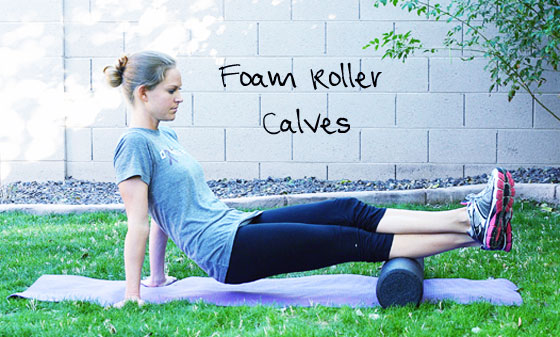






No comments:
Post a Comment